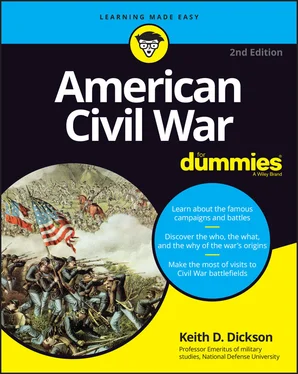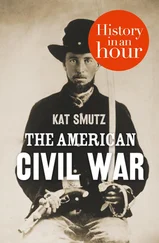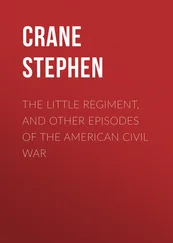Keith D. Dickson - American Civil War For Dummies
Здесь есть возможность читать онлайн «Keith D. Dickson - American Civil War For Dummies» — ознакомительный отрывок электронной книги совершенно бесплатно, а после прочтения отрывка купить полную версию. В некоторых случаях можно слушать аудио, скачать через торрент в формате fb2 и присутствует краткое содержание. Жанр: unrecognised, на английском языке. Описание произведения, (предисловие) а так же отзывы посетителей доступны на портале библиотеки ЛибКат.
- Название:American Civil War For Dummies
- Автор:
- Жанр:
- Год:неизвестен
- ISBN:нет данных
- Рейтинг книги:4 / 5. Голосов: 1
-
Избранное:Добавить в избранное
- Отзывы:
-
Ваша оценка:
- 80
- 1
- 2
- 3
- 4
- 5
American Civil War For Dummies: краткое содержание, описание и аннотация
Предлагаем к чтению аннотацию, описание, краткое содержание или предисловие (зависит от того, что написал сам автор книги «American Civil War For Dummies»). Если вы не нашли необходимую информацию о книге — напишите в комментариях, мы постараемся отыскать её.
American Civil War For Dummies,
American Civil War For Dummies
American Civil War For Dummies — читать онлайн ознакомительный отрывок
Ниже представлен текст книги, разбитый по страницам. Система сохранения места последней прочитанной страницы, позволяет с удобством читать онлайн бесплатно книгу «American Civil War For Dummies», без необходимости каждый раз заново искать на чём Вы остановились. Поставьте закладку, и сможете в любой момент перейти на страницу, на которой закончили чтение.
Интервал:
Закладка:
TABLE 4-1Army Structure
| Unit | Unit Multiples | Number of Soldiers |
|---|---|---|
| Company | 100 | |
| Regiment | 10 Companies | 1,000 |
| Brigade | 4 Regiments | 4,000 |
| Division | 3 Brigades | 12,000 |
| Corps | 3 Divisions | 36,000 |
TABLE 4-2Army Hierarchy and Command
| Unit | Commanding Officer |
|---|---|
| Regiment | Colonel Lieutenant or Colonel Major |
| Brigade | Brigadier General |
| Division | Brigadier General or Major General |
| Corps | Major General or Lieutenant General |
In 1861, two divisions made up a Union or Confederate army. In 1862, Union and Confederate armies were made up of corps, usually made up of three divisions, but an army could have any number of corps (which is why Civil War armies had such wide variances in numbers). Union armies were primarily named after major rivers (the Potomac, the Cumberland, the Ohio, the James). Confederate armies were named after locations or rivers (the Army of Northern Virginia in the east, the Army of Tennessee in the west). A major general commanded Union armies. A general commanded Confederate armies.
Strength and size of units
The official numbers are good to get an idea of structure and organization, but in reality, Civil War armies had wide variances in unit strength. Sickness, desertions, battle deaths, wounds, and furloughs (time off from military duty, usually to go home) took their inevitable toll. Regiments often were 500 men or below. By 1863, some veteran regiments in both armies were down to 200 men or fewer. The reason for this lies in the method by which regiments were initially recruited and organized. Volunteers filled the initial ranks of new regiments. After several months of combat, the original (and now understrength) volunteer regiments were rarely brought back up to original strength with other volunteers; instead, entirely new regiments of recruits or conscripts (individuals enrolled in the army by compulsion through law) would be added to the army. This was especially true for Union units. Needless to say, this caused tremendous organizational and administrative headaches for a division or corps commander. This situation also caused problems on the battlefield. Veteran units had to be assigned to divisions composed of mostly untested recruits. This practice kept the overall fighting quality of the Union army uneven. After the institution of conscription (compulsory military service), replacements for both Union and Confederate armies were brought into existing units to bring them up to nominal strength. As the war went on, brigades filled out their strength by adding a number of understrength but very combat-capable regiments. Near the end of the war a brigade contained anywhere from five to six regiments.
UNION AND CONFEDERATE CAVALRY: A COMPARISON
An interesting difference between the Union and Confederate cavalry was that the government provided a Union cavalryman a horse in the same way it provided a uniform and equipment. In the Confederate armies, a cavalryman had to provide his own horse. Needless to say, this led to a large number of well-off men joining the cavalry, although anyone who could procure a horse by any other means could become a cavalryman. Many Confederate cavalry raids in the war were launched specifically to capture horses. For a large part of the war, Confederate cavalry outperformed Union cavalry, because most of the troopers already had well-developed horsemanship skills. In the early part of the war, most of the Union troopers were still learning how to ride a horse, let alone fight on one.
Roles of different units in an army
In a campaign, armies and corps conduct large-scale maneuvers to gain an advantage and set the conditions for battle. Divisions are assigned objectives to attack — usually a piece of terrain (a hill, ridge, trench line, woods) occupied by an enemy force. Capturing this piece of terrain would give the attacker a significant advantage and cause the defender to be exposed to other attacks. In the defense, a division is given a stretch of ground to cover with its brigades, usually a critical piece of terrain that must be protected if the army is to survive. The division commander passes orders to his brigade commanders, who in turn pass the orders down to the colonels in the regiments. And anywhere from 400 to 1,000 men grimly take their places shoulder to shoulder on line. After all the strategy, campaigning, and maneuver, after all the generals have made their decisions, the battle is fought, and won or lost, at the regimental level.
Cavalry regiments
Union and Confederate cavalry regiments were organized much in the same way as infantry units, except cavalry companies were (and still are) called troops. A cavalry regiment had 12 troops. Cavalry units were considered independent and usually not deployed with infantry. Artillery batteries were attached to infantry brigades and divisions. An artillery reserve would be under control of either the corps or army commander.
Comparing the Science versus the Art of War
Anyone can master the principles of war. There is no secret to conducting military operations according to the principles of war. This is the knowledge base all military leaders use when employing military forces in war. But not every military leader is successful in war. The science of war alone cannot win battles — the art is what makes the difference. The mystique of warfare and its attraction, some may say, is in observing how well a military leader translates principles of war into action in real situations of life and death when the fate of the nation is at stake. A number of generals throughout history have gained immortality through their ability to take the science of warfare and translate it into something uniquely theirs, something that people call art. The American Civil War displays the talents of some of these masters of the art of war.
Chapter 5
Union and Confederate Strategy
IN THIS CHAPTER
 Tying strategy to political objectives
Tying strategy to political objectives
 Understanding the role a nation’s resources play in forming a strategy
Understanding the role a nation’s resources play in forming a strategy
 Examining the role of geography in shaping strategy
Examining the role of geography in shaping strategy
 Exploring the theaters of war
Exploring the theaters of war
Wars are fought with armies. But what guides the actions and purpose of armies in war? That’s where strategy comes in. Strategy is developed at the national level. In the case of the Civil War, the president and his military advisors dictated the strategy.
Strategy takes into account a number of important considerations. One of these is an assessment of the resources of the nation — essentially a measurement of its ability to conduct a war and sustain armies in the field. Another is the analysis of the geography. Geographical features can serve as an advantage or disadvantage, depending on your strategic approach.
Читать дальшеИнтервал:
Закладка:
Похожие книги на «American Civil War For Dummies»
Представляем Вашему вниманию похожие книги на «American Civil War For Dummies» списком для выбора. Мы отобрали схожую по названию и смыслу литературу в надежде предоставить читателям больше вариантов отыскать новые, интересные, ещё непрочитанные произведения.
Обсуждение, отзывы о книге «American Civil War For Dummies» и просто собственные мнения читателей. Оставьте ваши комментарии, напишите, что Вы думаете о произведении, его смысле или главных героях. Укажите что конкретно понравилось, а что нет, и почему Вы так считаете.












